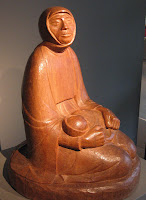 |
| Barlach with my favorite piece |
Before I entered the monastery, I lived in Germany, starting in Koln and moving to the Black Forest, where I studied wood carving. Living in Koln in the late 60s was exciting art-wise as there was so much being restored from the massive bombings of WW II. It seemed there was a church on every corner and one of my favorites to visit was the medieval Antoniterkirche.
 |
| Angel in Antoniter Kirche |
The church served as a monastery of the Antoniter Order from the 14th century until 1802 when it was closed and remanded to the Evangelicals. The church became Cologne's first Protestant place of worship when it was again opened in 1805. In this famous church hangs an amazing sculpture by one of my favorite German artists ERNST BARLACH (1870-1938). He was a German expressionist sculptor, printmaker and writer.
A trip to Russia in 1906 was one of the greatest influences on him and his artistic style and is reflected in some of my favorite works. The powerful and folk-like design of his sculptures after reflect the impressions of rugged farm-life and Russian folk art.
 |
| Mother & Child (my favorite) |
 |
| Begging Woman (another favorite) |
The essence of Ernst Barlach’s art lay in his ability to express his devotion to and love for his fellow human beings in drawings and sculptures. Marginal figures in society, the needy, the broken, the outcast, remained the focus of his art. In radical opposition to the fascist ideology of “community”, he addressed the existential loneliness of the individual.
While his favorite aspect of man was sufferings of humanity he also saw a lighter side as the singing man and laughing old woman.
 |
| Singing Man |
 |
| Old Woman Laughing |
Ernst Barlach’s work was an outcry of the oppressed yet his depictions also transported the spirituality and the humanness of everyday people. He used emphatic gestures and angular poses to convey strong emotion and movement. "I desire nothing more than to be an artist, after a fashion. It is my belief, that whatever cannot be expressed in words, can be passed on to another by means of forms.”
Obviously, such art created many conflicts during the rise of the Nazi Party, when most of his works were confiscated as degenerate art. You can be sure that anything banned by the Nazis, was real art!
In 1936, when Barlach's works were confiscated during an exhibition together with the works of KATHE KOLLWITZ (Blog to follow). Barlach himself was prohibited from working as a sculptor, and his membership in the art academies was canceled. This rejection is reflected in his final works before his death from heart failure in 1938 in Rostock, Mecklenburg.
 |
| Monks Reading |
What drew me to him was his ability to show contrast between spirit and body, between heaviness and lightness, between attachment to the earth and spirituality.
 |
| The Holy Family |
 |
| Monk Reading |
Today, Ernst Barlach is known as one of the most important sculptors of Classical Modernism.